#a natural evolutionary progression).
Text
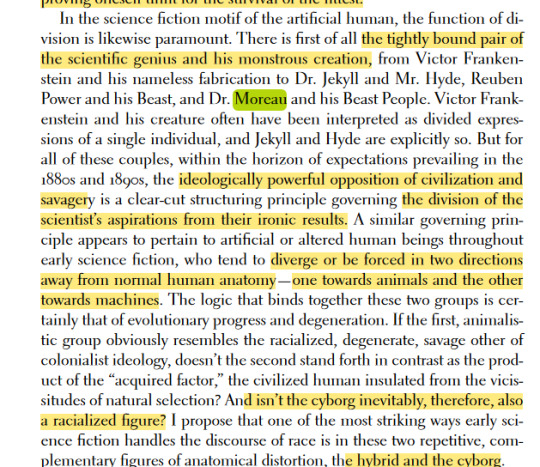
HYBRID-CYBORG DUALISM IN ONE BEING MY BELOVED
#through being made a cyborg in the aim of evolutionary progress#he becomes the very enslaved beast he's been told he was all his life#like the way the hybrid is a metaphor for the colonized subject only ever half-civilized and unevolved#closer to animal than to the colonial standards of man#and anakin all his life striving for the status of humanity. of beyond. greater than humanity.#an escape from the so-called servility of his own nature#and the way palpatine offers him that by literally mutilating him and grafting animal parts onto his body. rendering him a forever slave.#but he is indeed beyond human. more powerful. beyond the confines and limits of human strength and longevity and failibility#does he know? does he realize what he's been made into? Or is it just everyone else who can see it#but it doesn't matter what they see because now its only him and his master for the very rest of time
3 notes
·
View notes
Text
Saturn in houses
In astrology, Saturn signifies your sense of duty, responsibilities, setbacks, obstacles and karmic lessons.
For entertainment purposes only


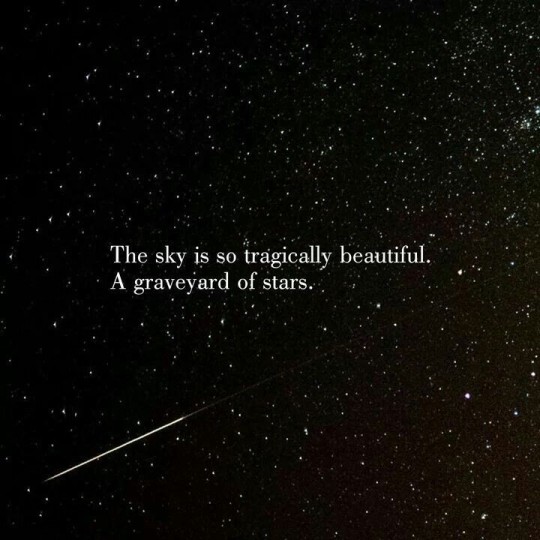
Saturn in first house
Saturn's presence here can make the individual serious, disciplined, and responsible. They may appear mature beyond their years, with a reserved demeanor. They might have a lean or bony physical structure. Individuals with Saturn in the first house may struggle with self-esteem or self-worth issues. They might feel a sense of inadequacy or pressure to meet high standards, both internally and externally imposed. Saturn's influence can affect the health, particularly the skeletal system, joints, teeth, and skin. These individuals may be prone to ailments like arthritis, dental issues, or skin problems. However, with proper discipline and care, they can maintain good health. Saturn's placement here can bestow a strong sense of ambition and determination. They are willing to work hard and endure challenges to achieve their goals. However, they may also face delays or obstacles along the way, which teach them patience and resilience. Saturn in the first house can indicate a cautious approach to relationships. These individuals may take their time to trust others and establish deep connections. They seek stability and commitment in partnerships but may struggle with expressing emotions openly. These individuals are often drawn to professions that require discipline, responsibility, and long-term planning. They may excel in fields such as management, law, engineering, or politics. However, they may face challenges or delays in their career progression, which require perseverance to overcome. Saturn's influence here can also lead to a deep introspective nature and a quest for spiritual understanding. These individuals may seek meaning and purpose in life through self-discipline, meditation, or religious practices.
Saturn in second house
Saturn in the second house often indicates a serious approach towards finances. It can bring financial stability through hard work, discipline, and long-term planning. However, there may also be delays or obstacles in financial matters, teaching the individual important lessons about managing resources wisely. Saturn here instills a strong sense of values and principles related to money, possessions, and personal worth. The individual may place great importance on security, frugality, and practicality in their approach to wealth accumulation. This placement can sometimes create tension or responsibilities within the family regarding financial matters. There may be a sense of duty towards family members, especially in providing financial support or taking care of elderly relatives. Saturn's influence can lead to cautious or reserved communication, especially regarding matters related to money and possessions. The individual may be careful with their words and prefer to speak only when necessary. Individuals with Saturn in the second house may struggle with feelings of inadequacy or low self-esteem, particularly in relation to their financial status or abilities. However, with effort and perseverance, they can gradually build a stronger sense of self-worth and confidence. While Saturn's influence may initially manifest as limitations or obstacles, it also rewards diligent effort and persistence. Over time, the individual can achieve material success and financial security through disciplined work and responsible management of resources. There may be a tendency to be conservative or cautious with money, preferring safe and stable investments over risky ventures. This approach can lead to slow but steady growth in wealth over time. Saturn in the second house often indicates karmic lessons related to finances, values, and self-reliance. The individual may need to confront and overcome challenges in these areas to fulfill their soul's evolutionary journey.
Saturn in third house
The third house represents communication, siblings, courage, and self-expression. Saturn here can indicate challenges or delays in communication. It may suggest a reserved or serious demeanor in speech. Relationships with siblings may be characterized by responsibility, duty, or even distance. Saturn in the third house enhances determination and discipline in communication and intellectual pursuits. Individuals may have a structured approach to learning and may excel in subjects that require focus and perseverance, such as mathematics or technical fields. Saturn's presence in the third house can bring obstacles and challenges in matters related to communication, short-distance travel, and interactions with neighbors or relatives. These challenges may serve as opportunities for personal growth and maturity, but they can also lead to feelings of frustration or limitation. Individuals with Saturn in the third house tend to have a practical and realistic approach to life. They may be cautious in their decision-making and prefer to rely on logic rather than intuition. This placement encourages careful planning and attention to detail in all areas of life. Saturn's placement in the third house can indicate a sense of responsibility towards siblings or younger relatives. These individuals may take on the role of a mentor or guide for their siblings, offering support and practical advice when needed. Saturn in the third house instills a strong work ethic and a willingness to put in the necessary effort to achieve one's goals. Individuals with this placement are likely to be diligent and hardworking, especially in areas related to communication, writing, or teaching. Success and recognition may come later in life for individuals with Saturn in the third house. They may need to overcome various obstacles and challenges before achieving their goals, but the rewards are likely to be long-lasting and well-deserved.
Saturn in fourth house
Saturn's placement in the fourth house often brings a sense of responsibility and seriousness to matters related to home and family. It may indicate a person who takes their family duties seriously, perhaps even feeling burdened by familial obligations at times. Saturn's influence can lead to a more reserved and disciplined approach to emotions. Individuals with this placement may struggle with expressing their feelings openly and might prefer a structured or traditional approach to emotional matters. Saturn in the fourth house can indicate a strong focus on property, land, and real estate matters. It may suggest delays or challenges in acquiring or managing property, but with perseverance, individuals can achieve stability in this area. The influence of Saturn in the fourth house can reflect a significant influence from one or both parents, particularly the father. There may be a sense of authority or strictness associated with parental figures, shaping the individual's upbringing and values. This placement can bring a deep-seated need for security and stability, both externally in the home environment and internally within oneself. Individuals may work diligently to establish a solid foundation in life, striving for long-term security and comfort. Saturn's placement in the fourth house may indicate a propensity towards introspection and a serious approach to inner growth. Individuals may grapple with deep-seated fears or insecurities, but through self-discipline and perseverance, they can achieve profound psychological insights and personal transformation. There may be a strong attachment to cultural heritage, traditions, and ancestral roots with Saturn in the fourth house. Individuals may feel a sense of duty to preserve family customs and values, even in the face of modern challenges or societal changes. Saturn's presence in the fourth house can bring various challenges and lessons related to home, family, and emotional security. These challenges often serve as opportunities for growth and maturity, teaching individuals valuable lessons about resilience, responsibility, and self-reliance.
Saturn in fifth house
The 5th house governs creativity, self-expression, intelligence, education, and children. Saturn's presence here may indicate a disciplined approach to creativity and self-expression. These individuals may have a structured and methodical approach to artistic endeavors, preferring traditional or time-tested methods over impulsivity. They may excel in fields requiring deep concentration, such as research, writing, or technical subjects. Saturn's influence in the 5th house can bring a serious and studious attitude towards education. These individuals may value knowledge and learning deeply, often pursuing higher education or specialized training with dedication and perseverance. However, there may be delays or obstacles in academic pursuits, requiring patience and persistence to overcome. Saturn's presence in the 5th house may bring challenges and responsibilities related to children and parenthood. There may be delays or difficulties in conceiving children, or the individual may take a cautious and disciplined approach to parenting. They may instill a strong sense of discipline and responsibility in their children, emphasizing the importance of hard work and perseverance. In matters of romance and relationships, Saturn in the 5th house may indicate a reserved or cautious approach. These individuals may be selective and practical when it comes to matters of the heart, preferring stable and long-lasting relationships over fleeting passions. They may also experience delays or challenges in finding romantic fulfillment, requiring patience and perseverance in matters of love. The 5th house also governs speculative ventures, gambling, and risk-taking activities. With Saturn here, individuals may approach these areas with caution and conservatism. They are unlikely to take unnecessary risks and may prefer to invest time and effort in more secure and stable pursuits. However, if they do engage in speculative activities, they are likely to do so with careful planning and analysis.
Saturn in sixth house
The sixth house represents service, daily work routines, health, enemies, obstacles, and conflicts. With Saturn here, the native tends to take their responsibilities seriously and may excel in professions that involve service or helping others. They are likely to be hardworking, methodical, and dedicated to their duties. Saturn's presence in the sixth house can indicate a strong focus on health matters. The native may face health challenges or chronic conditions, but they have the resilience to overcome these obstacles through discipline and perseverance. It's essential for them to maintain a structured and disciplined approach to health and well-being. Saturn in the sixth house suggests that the individual may face challenges or delays in their work environment. They may encounter demanding bosses, bureaucratic hurdles, or a heavy workload. However, they have the patience and endurance to handle these challenges effectively and emerge stronger from them. The sixth house is also associated with enemies and conflicts. Saturn here indicates that the native may face opposition or conflicts in their life, but they have the ability to deal with adversaries with maturity, caution, and strategic planning. They prefer to resolve conflicts through diplomacy and negotiation rather than confrontation. Individuals with Saturn in the sixth house often find fulfillment in serving others or working in fields that contribute to the well-being of society. They may excel in professions such as healthcare, social work, counseling, or public service where their disciplined approach and sense of duty can make a significant impact. Saturn's placement in the sixth house suggests that the native is working through karmic lessons related to service, responsibility, and overcoming obstacles. They may need to learn the value of self-discipline, humility, and perseverance in their journey towards personal growth and fulfillment.
Saturn in seventh house
Saturn in the seventh house often brings a sense of responsibility, seriousness, and maturity to relationships. It can indicate delays or obstacles in finding a suitable partner or in the process of getting married. However, once committed, individuals with this placement tend to take their partnerships very seriously and may prioritize stability and longevity over passion. Individuals with Saturn in the seventh house may feel a strong sense of duty and obligation towards their partners. They are likely to approach relationships with caution and practicality, preferring to establish a solid foundation before fully committing. Saturn's presence in the seventh house can bring challenges and lessons in the realm of partnerships. These challenges may include issues related to commitment, communication, or power dynamics within relationships. However, overcoming these challenges can lead to personal growth and maturity. This placement can also indicate success in business partnerships, particularly those that involve long-term planning, discipline, and hard work. Individuals with Saturn in the seventh house may excel in professions that require negotiation, diplomacy, and strategic thinking. Saturn in the seventh house often indicates karmic lessons and connections in relationships. Past life karma may play a significant role in the dynamics of partnerships, with lessons related to duty, responsibility, and mutual support. Depending on other factors in the birth chart, Saturn in the seventh house can sometimes indicate delays or obstacles in marriage. However, these delays are often temporary and can be overcome with patience, perseverance, and maturity. Despite the challenges, individuals with this placement are likely to have long-lasting and stable relationships. They have the ability to weather storms and overcome obstacles through their patience, perseverance, and commitment to their partners.
Saturn in the eighth house
Saturn in the eighth house often indicates a life marked by profound transformations and significant changes. These changes may be intense and may occur suddenly or through challenging circumstances. The individual may undergo various upheavals and experiences that lead to inner growth and evolution. This placement suggests a deep, intense, and introspective nature. The individual is likely to explore the depths of their own psyche and may have a keen interest in esoteric subjects, mysteries, and occult phenomena. They may possess a penetrating insight into the hidden aspects of life and may be drawn to explore taboo subjects or unconventional practices. Saturn in the eighth house can also indicate concerns or challenges related to inheritance, joint finances, or legacies. There may be obstacles or delays in matters pertaining to shared resources, taxes, insurance, or inheritances from others. However, with patience and perseverance, the individual can navigate these challenges and eventually establish a stable foundation in these areas. Individuals with this placement often develop a strong sense of psychological resilience and inner strength. They have the capacity to endure adversity and hardship, emerging from difficult situations with newfound wisdom and maturity. Saturn's influence in the eighth house instills a sense of discipline, responsibility, and determination, which enables the individual to confront life's challenges with courage and fortitude. Saturn's placement in the eighth house can also signify a profound spiritual journey characterized by deep introspection, inner purification, and spiritual transformation. The individual may be drawn to spiritual practices such as meditation, yoga, or metaphysical studies, seeking to unravel the mysteries of existence and attain higher states of consciousness. Saturn in the eighth house may indicate a karmic reckoning, where past actions and debts come to the forefront for resolution. The individual may be confronted with karmic lessons related to power dynamics, trust, betrayal, and emotional intimacy. Through facing these challenges head-on, they have the opportunity to transcend limitations and evolve spiritually.
Saturn in ninth house
Saturn in the ninth house suggests a deep-seated interest in spirituality, religion, and philosophy. The individual may have a strong sense of duty and responsibility towards understanding the deeper meaning of life and may embark on a quest for spiritual truth. These individuals tend to have a serious and philosophical outlook on life. They may be drawn to ancient wisdom, traditional teachings, and may seek guidance from spiritual gurus or mentors. Saturn's presence can bring challenges and delays in higher education. The individual may face obstacles in academic pursuits or may have to work harder to achieve academic success. However, perseverance and dedication can lead to eventual success. Saturn in the ninth house often indicates that wisdom and knowledge are acquired through life's experiences and hardships. The individual may have to overcome various trials and tribulations to gain profound insights and understanding. These individuals may hold conservative or traditional beliefs, and they may be resistant to change. They prefer stability and security in their philosophical and religious beliefs, often adhering to age-old traditions and customs. Saturn here can indicate limitations or restrictions in long-distance travel. It may require careful planning and organization, and there may be delays or obstacles during journeys. However, travel undertaken with a purpose, such as for educational or spiritual purposes, can be beneficial. The relationship with the father may be characterized by seriousness, discipline, or distance. The father may play a significant role in shaping the individual's philosophical and moral values, but there could also be challenges or responsibilities associated with this relationship. Despite the challenges posed by Saturn, individuals with this placement can achieve success and fortune through discipline, hard work, and perseverance. They are capable of building a solid foundation for their future, especially in fields related to law, spirituality, teaching, or philosophy.
Saturn in tenth house
Saturn in the tenth house imbues the individual with a strong sense of responsibility, discipline, and perseverance in their professional endeavors. They are likely to take their career seriously and understand the importance of hard work and commitment. Individuals with Saturn in the tenth house are often career-oriented and may prioritize their professional goals above other aspects of life. They are willing to put in the necessary effort and sacrifice to achieve success in their chosen field. Saturn's placement here may grant the individual leadership qualities and the ability to handle positions of authority with maturity and wisdom. They may excel in managerial roles or positions that require them to take charge and make important decisions. While Saturn brings stability and structure, its placement in the tenth house can also indicate challenges and obstacles in the individual's career path. They may face delays, setbacks, or struggles in achieving their goals, but these experiences ultimately serve to strengthen their character and resilience. Saturn in the tenth house can influence the individual's public image and reputation. They may be perceived as reliable, competent, and respected by their peers and superiors. However, they may also be cautious about how they present themselves to the world, striving to maintain a professional and dignified demeanor. Individuals with this placement may have a traditional approach to their career and may prefer established, conventional paths rather than taking risks or exploring unconventional options. They value stability and security in their professional life. Saturn in the tenth house encourages the individual to focus on long-term goals and legacy-building. They may have a strong sense of duty towards leaving a lasting impact in their field or making meaningful contributions to society. In Vedic astrology, Saturn is also associated with the father. Its placement in the tenth house can indicate a significant influence or involvement of the father in the individual's career path and professional development.
Saturn in the eleventh house
Saturn's presence here can indicate that the native takes their friendships seriously and may have a small but close-knit circle of friends. These friendships may endure for a long time but could also involve responsibilities or limitations. Saturn's influence in the eleventh house can lead to slow but steady growth in income and gains. However, there may be delays or obstacles in achieving financial goals. The native may need to work hard and demonstrate discipline and perseverance to attain financial stability. Individuals with Saturn in the eleventh house may have ambitious goals and aspirations. They are likely to be cautious and practical in pursuing their dreams, preferring to plan meticulously and work methodically towards their objectives. Saturn's placement here often emphasizes social responsibility. The native may be involved in community or humanitarian efforts, driven by a sense of duty towards society. They may also encounter challenges or obstacles in achieving their social or collective goals. Saturn's presence can make the native cautious in forming new associations or joining groups. They may prefer quality over quantity in their social networks and may be selective about the causes or organizations they align themselves with. Individuals with Saturn in the eleventh house tend to have a long-term perspective on life. They are strategic in their approach and may invest time and effort in endeavors that promise long-lasting results, even if the rewards are delayed. Saturn's placement in any house brings karmic lessons, and in the eleventh house, these lessons often revolve around detachment, discipline, and responsibility within social and group dynamics. The native may need to learn to balance their individual aspirations with their obligations towards others.
Saturn in the twelfth house
Saturn in the twelfth house often indicates a deep interest in spirituality and introspection. These individuals may be drawn to meditation, yoga, or other spiritual practices as a means of seeking inner peace and understanding. There may be periods of isolation or a sense of being excluded from mainstream society. This placement can indicate a preference for solitude or a need to withdraw from the hustle and bustle of the external world. Saturn in the twelfth house can suggest a strong sense of duty towards serving others or making sacrifices for the greater good. These individuals may find fulfillment through acts of charity, service-oriented professions, or involvement in humanitarian causes. The twelfth house is often associated with karmic debts and past life experiences. Saturn's presence here may indicate a need to confront and resolve unresolved karmic issues or to fulfill duties left unfinished from previous lifetimes. Individuals with this placement may face obstacles and limitations in their life journey, particularly in matters related to the twelfth house themes such as spirituality, endings, and hidden enemies. However, these challenges can serve as opportunities for growth and self-discovery, as Saturn encourages perseverance and discipline. Saturn in the twelfth house can suggest connections or experiences with foreign lands, cultures, or people. These individuals may feel a strong affinity for foreign languages, travel, or living abroad. Despite the challenges posed by this placement, individuals with Saturn in the twelfth house often possess a profound inner strength and resilience. They have the ability to endure hardships and setbacks with patience and fortitude, ultimately emerging stronger and wiser from their experiences.
Masterlist



#saturn in the 7th house#saturn astrology#saturn#saturn in the 1st house#saturn in houses#astro notes#vedic astrology#astrology#vedic notes#venus astrology#astro observations#astro community#tarot deck#tarot readings#pick a card#tarot#astroblr
2K notes
·
View notes
Text
Chekhov Reads Dungeon Meshi: CH49
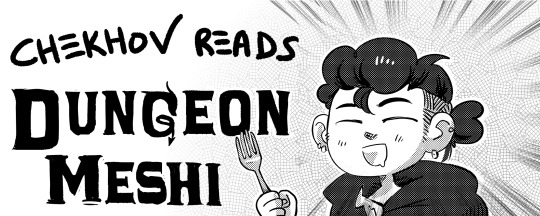
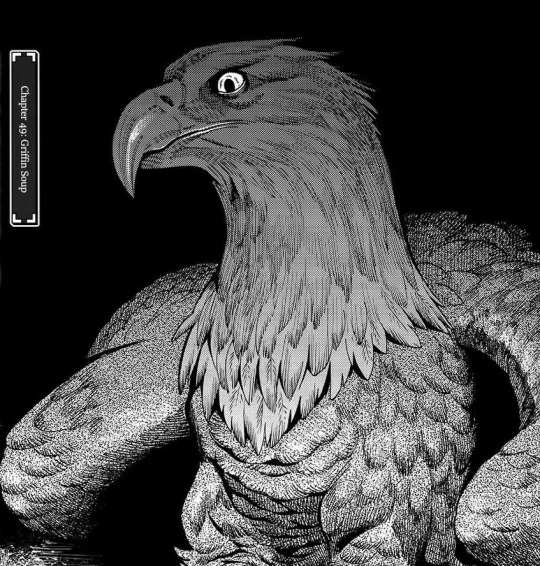
Mmmmmbig chicken.
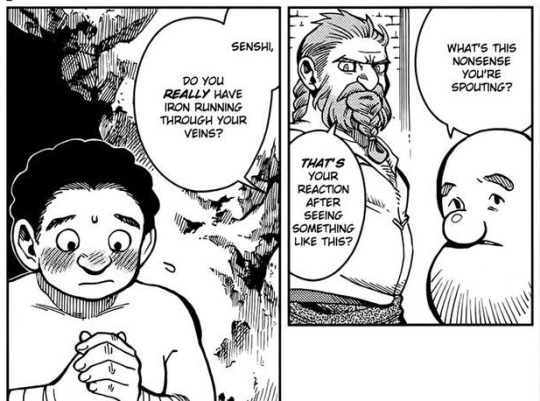
It's not non-sense, it's common-sense. But dang, orcs really have that toxic adventuring gender stuff down, huh.

Dwarves are comprised of many basic shapes, such as...... cube....and.......two circle.....
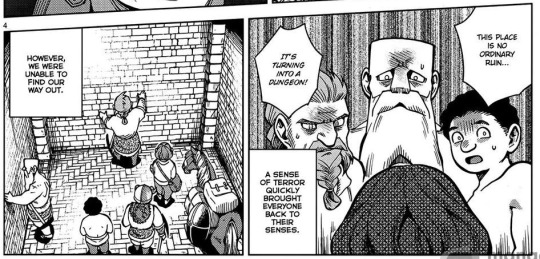
.....It's..........TURNING into a dungeon.
Like an architectural structure has a natural evolutionary progression, including, apparently, becoming a dungeon if enough magic leaks into it? This is fascinating. Like magical radiation that poisons the natural architecture and creates monsters. That's fucked up.
But I need to know more immediately.
Though wait, I think Marcille's flashback chapters talked about creating and maintaining dungeons so it MUST be a well understood phenomenon.
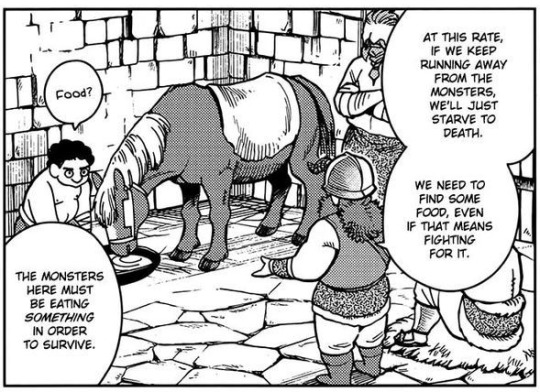
It's a small detail, but the group having a horse (pony?) with them and Senshi later getting attached to a horse-like monster feels extremely intentional. I wonder if it'll be explicitly mentioned or if I'm just reading too much into things.

......Anne was the name of the Kelpie. :( That's 100% of purpose. Oh no. Why do you do this to me.

....aaaand that's where Senshi's strong parental instincts kick in.

................................ damn, poor kid.
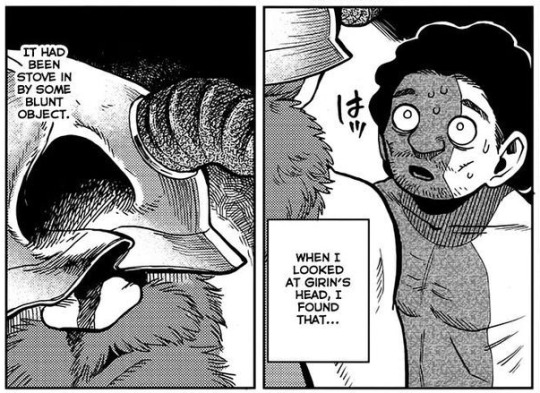
Dwarves are tough. A part of me wonders if that guy was hanging on to whatever life he had left, just barely making it through to feed Senshi........ A walking corpse, by all other names, hanging on for the sake of it.

It's really cool to see Senshi grow so much in the span of a few panels. And the orcs softening up is such a common theme it's not even surprising.
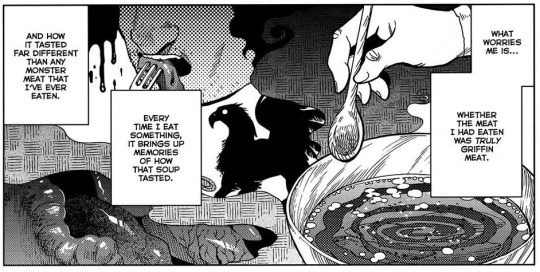
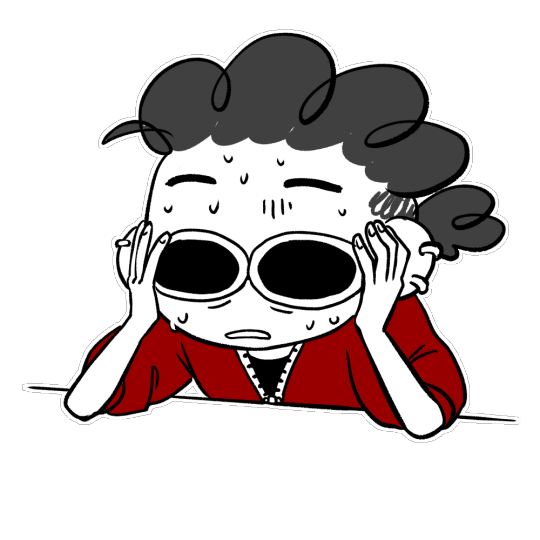
Oh.
OH.
Oh no.
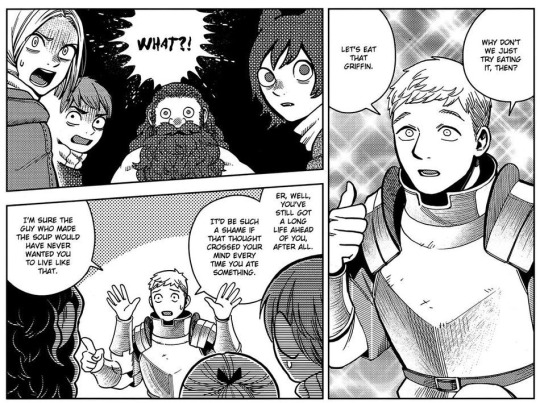
He's a fucking idiot but it's like. Healing? How stupid he is.
It's a level of not giving a fuck that you can aspire to.
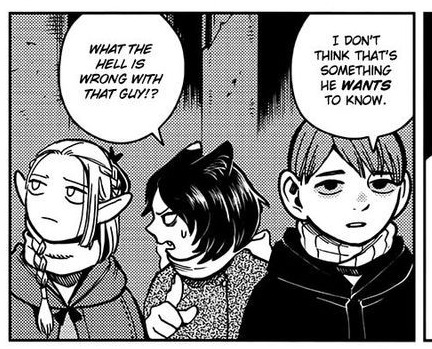
Marcille like "let me see if I can get you an itemized list....."
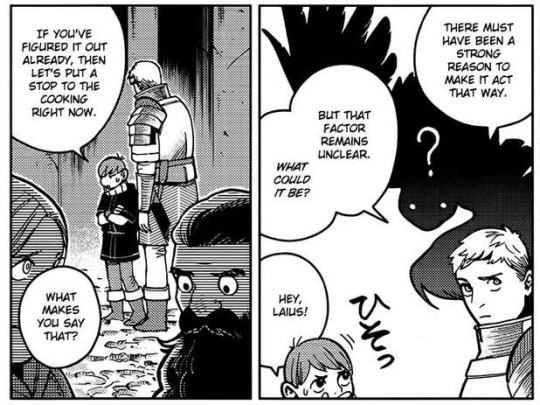
Laios pls.
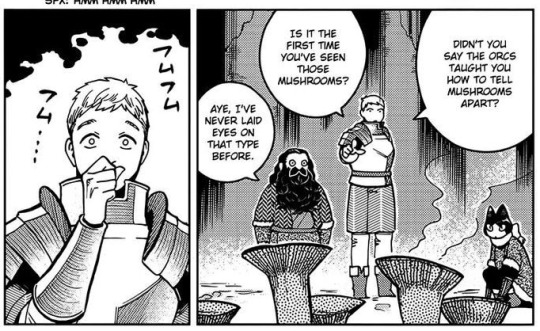
This boy is Sherlocking the fuck out of SOMETHING but I can't tell what.

Laios is an unstoppable force. He does not give a fuck.
But also. Hippogriff?
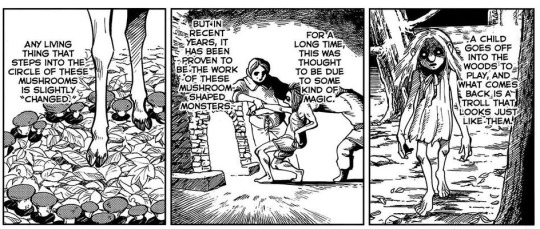
You're telling me a shroom mushed this Hippogriffin?
Okay, but seriously. "Step into the magic mushroom circle to clip through the floor and break your model by downloading a new unapproved mod" sounds JUST like something the dungeon would have.

well hey! The kick had a reasoning behind it!

humans: we wanna unlock the secrets of genome editing!
Mushroom CRISPR:


okay why is this genuinely getting to me.
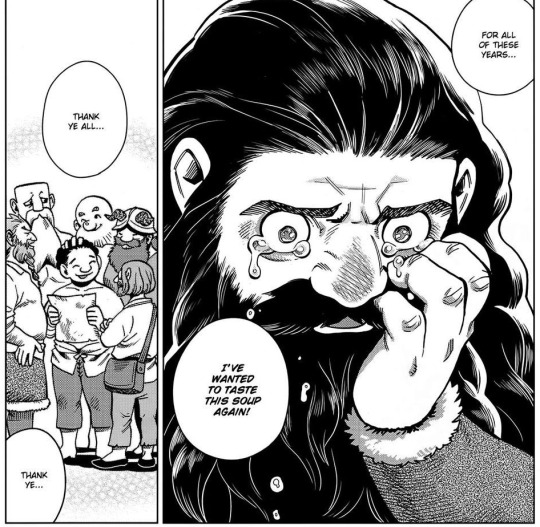
(;´༎ຶД༎ຶ`)
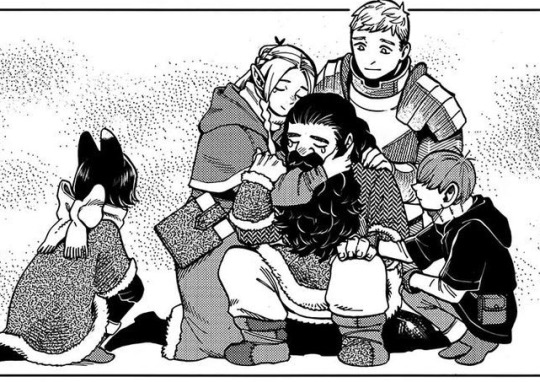
Bro. I love them.

AAAAA NOT THROUGH THE GENE EDITING CIRCLE
449 notes
·
View notes
Note
thots on astrology? related, thoughts on mbti?
k i like that you guys just pop in my inbox from time to time and invite me to run my mouth about topics and concepts. like truly what else is this website for.
anyway astrology (& sorry, most of what i know here pertains specifically to europe in the middle ages onward) is genuinely such a bizarro historical case of a science whose core epistemological presupposition (a geocentrist and specifically anthropocentrist cosmology) has completely fallen out of favour in both popular and professional discourse, and i don't think most people appreciate how weird it is for astrology to continue existing with this degree of popular and mainstream participation lol. like most fringe science actually bothers to have some semblence of its own reactionary epistemology to fall back on; astrology just doesn't seem to care. it would be like if the medical guilds fully endorsed the position that blood is circulated in the human body by the heart, but then also recommended as treatments for clotting disorders medical practices that only make sense on the supposition that the liver is the origin of all blood and is continuously creating more of it. like no other science that i can think of tries to have it both ways to the extent astrology does. like, one reason phrenology and eugenics are bad comparison points here is because they're very much copacetic with post-enlightenment naturalism and evolutionary transpositions in the social sciences. astrology, like, intellectually is not and yet here it is anyway. ideology innit.
anyhow i assume the reason you asked about this in conjunction with mbti is because today's astrology is largely purporting to provide psychological analysis and is therefore more similar to a system like mbti than to the historical use of star-reading as a predictive science. obviously both astrology and mbti are deeply reactionary in this respect and belong to a larger trend toward attempting to categorise, measure, and taxonomise the psyche, tho an important difference here is that mbti has hereditarian elements, which no form of astrology that i know of does. i think astrology's shift in the personal-psychological direction has to do with a few different factors, including medical astrological practice (orthodox in the european middle ages, then varying degrees of heterodox from the early modern period onward) and self-help movements in the 20th century.
but in any case it, mbti, and similar attempts at psychometry are, like, staggeringly essentialist in conception and practice, and i do think their current popularity reflects some deeply reactionary tendencies amongst people who often (not always) consider themselves otherwise progressive or leftist. it's honestly kind of worrisome how many people will jump on a project that explicitly aims to define static and immutable human 'types' as long as it's dressed in quasi-spiritual or psy-scientific terminology. like i do think we all need to pause and think about the ideological ends and consequences of how we talk about each other and our bodies, minds, and birth circumstances 😵💫
831 notes
·
View notes
Text
rambling about slugcats
I’m probably not the first to notice this but I personally haven’t seen anyone else bring it up so I wanna talk about it.
I realized that as the timeline progresses, the slugcats become progressively less carnivorous.
While spearmaster has a different way of eating, they mostly feed off of the energy of other living animals, with the exception of popcorn plants.
Both artificer and hunter are technically able to eat plants as well as small insects, though they much prefer the meat of other larger creatures. Artificer, who is earlier in the timeline, also has the maul ability, which likely means that it has stronger sharper teeth. While inv isn’t canon, it also fits in its place between arti and hunter here, sharing the maul ability with artificer.
Gourmand gains less nutrition from other larger animals than hunter or artificer do, though in return they are more adapted to eating plants and smaller insects.
Survivor, monk and rivulet eat only plants and insects. While monk could be considered more passive than rivulet, this is probably just the nature of monk as a character rather than an evolutionary thing, especially as survivor and monk are around at basically the same time. Rivulet is however more equipped to simply flee any encounter with a threat rather than engage in combat.
Saint is fully vegetarian (just don’t tell them about bluefruit). Their digestive system does not tolerate meat at all. Attempting to eat a smaller creature like a batfly will cause them to collapse while trying to eat a centipede will result in instant death.
Of course some of these cats can be described as anomalies in their own right, either due to being purposefully created by iterators or whatever is going on with saint, but when it comes to food, this progression does look to be quite linear.
It’s very possible that slugcats were previously a fully carnivorous species, but then evolved to be mainly insectivorous, while also growing more adapted to plants.
I just thought this was neat and wanted to share. Anyone is free to give their own input on this as well
165 notes
·
View notes
Text
Consider the twin master sciences of the twentieth century, neoclassical economics and population genetics. Each of these disciplines came to power in the early twentieth century with formulations bold enough to redefine modern knowledge. Population genetics stimulated the “modern synthesis” in biology, uniting evolutionary theory and genetics. Neoclassical economics reshaped economic policy, creating the modern economy of its imagination. While practitioners of each have had little to do with each other, the twins set up similar frames. At the heart of each is the self-contained individual actor, out to maximize personal interests, whether for reproduction or wealth. Richard Dawkins’s “selfish gene” gets across the idea, useful at many life scales: It is the ability of genes (or organisms, or populations) to look out for their own interests that fuels evolution. Similarly, the life of Homo economicus, economic man, is a series of choices to follow his best interests.
The assumption of self-containment made an explosion of new knowledge possible. Thinking through self-containment and thus the self-interest of individuals (at whatever scale) made it possible to ignore contamination, that is, transformation through encounter. Self-contained individuals are not transformed by encounter. Maximizing their interests, they use encounters—but remain unchanged in them. Noticing is unnecessary to track these unchanging individuals. A “standard” individual can stand in for all as a unit of analysis. It becomes possible to organize knowledge through logic alone. Without the possibility of transformative encounters, mathematics can replace natural history and ethnography. It was the productiveness of this simplification that made the twins so powerful, and the obvious falsity of the original premise was increasingly forgotten. Economy and ecology thus each became sites for algorithms of progress-as-expansion.
Anna Lowenhaupt Tsing, The Mushroom at the End of the World: On the Possibility of Life in Capitalist Ruins
90 notes
·
View notes
Text
I think I want to add Dinosaurs
I am easily influenced and manipulated by what I see and hear. Literally listening to a podcast about not-dinosaurs and it mentioned dinosaurs and now I'm thinking - I don't think I've encountered the idea of using space tech to bring back dinosaurs in any of these, I'm sure there's plenty I just don't know of them, yet. I know some have things like dragons and other monstrous creatures. Warhammer 40K has space elves riding dinosaurs. Dinosaurs are cool.
______________________________________
Hailing from a Deathworld, Earth's flora and fauna, including Humans, are quite sturdy and potent. Unfortunately, it is as a result of a seemingly incomprehensible mix of hundreds and billions of organisms, evolutionary necessity they call "survival of the fittest", and, sometimes, just sheer willpower. Not something easily replicable for the majority of species within the Galactic Coalition.
So when we learned one of their stations is purpose designed to revive long extinct local species called dinosaurs - a very loose term that encompasses millions of wildly different and unrelated species across a greater time span than even some of the most ancient galactic civilizations, let alone a relatively infantile one such as Humanity, we were, once again, worried.
These creatures were massive beasts of pure power, teeth, claws, bulk, even organic armor and certain kinds of naturally evolved weapons! Most Humans have nothing but respect, fear, and awe towards them. And they want to bring them back. We're already getting too used to hearing this response, but still we had to ask why.
"It'll be so cool! Dinosaurs!! In Space!!!"
"Just imagine - a giant 3 meter tall T-Rex, kitted out with a dragon pattern armor plates, twin mini-guns mounted on its sides, friggin' laser beam goggles!, me riding it with a energy sword, holding Earth's flag and being all - Fuck yeah!"
We thought these experimental science stations housed the brightest minds Humanity had to offer, paragons of knowledge, creativity, invention, and progress. Are our translators working right? Or is Humanity just... crazy?
#humans are deathworlders#humans are space oddities#humanity fuck yeah#humans are space australians#humans are space orcs#carionto#dinosaurs in space
143 notes
·
View notes
Note
For funsies, do you have thoughts about what pokemon each Cullen would be most likely to have? Like idk why but I picture Emmett with a Growlithe
I swear to god I had answered this somewhere but since I can't find it, I doubt others can find it.
Let's do it.
Alice
Per the Pokemon universe, Alice is very clearly a psychic and while a powerful one is more or less bog-standard and less terrifying than Sabrina.
I imagine Alice would have a Kadabra and they would have great fun together as Alice communicates for them and uses them to teleport her places she wishes to go.
Bella
Bella has an Eevee, not only is it appropriately normal/non-interesting looking but it's very vulnerable looking, weak compared to its potential evolutionary forms, and has that evolutionary potential to become almost anything for all Bella wouldn't really recognize that fact.
She'd love Eevee because it's a normal type, just like her, because Bella is so normal it hurts.
"Bella, that means only fighting types are super effective against you"
"I am so average."
Carlisle
Carlisle has a Chansey that becomes a Blissey that is his wife Esme. See, Carlisle was working at a Pokemon Center (as one does) and one day came in a tragic Chansey that had had to run away from its trainer and in the process lost its egg.
Everyone had given up on Chansey and Carlisle, cursing himself for being a vampire and probably terrifying the life out of her, ends up taking her home.
Chansey thrives in her new environment and, as all Chansey do, becomes progressively weird the more happy she is. Chansey evolves into a Blissey, a creature that will run at lightening speeds to offer you an egg in your time of need.
It is accepted in the Cullen household that Esme the Blissey is the Cullen mom. It's so accepted, they forget it's weird.
Bella comes to their house and Edward promises she'll love his mother.
Who is his mother?
The Blissey making Italian food in the kitchen because Isaballa is Italian right? (Despite Blissey only saying "Blissey" the plot does not change at all and Bella just assumes that when Blissey goes on a long chirping rant to her it's about how great Edward is.
Yeah, Edward must be her favorite blood sucking child.)
Edward
Edward doesn't have a pokemon.
This is because as a vampire he didn't want to corrupt a good, benign, pokemon with his presence (only the fact that Carlisle and Esme are so pure prevents him from feeling too terrible about Esme). So, Edward wants to gravitate towards more... ah... let's call them tempermental pokemon such as Gengar.
However, Edward doesn't actually want a Gengar, as he wants to be a good person worthy of the world, and a Gengar also doesn't want him for that same reason.
When he meets Bella, there's a dramatic moment where she helps him accept that he too can have a pokemon like a real boy. As Bella tells him what to get, and he wants to impress her, I imagine he gets a Dragonair as it's so beautiful and elegant, just like Bella thinks Edward is (he's never allowed to evolve it into a herp de derp Dragonite).
Emmett
Growlithe and Arcanine in the pokemon world I think are a little too associated with duty/law enforcement to quite be Emmett's thing. Growlithes, while dogs, are very much watch dogs and have a steadfast seriousness when it comes to protection/the law or what have you.
I'm really struggling with him, actually.
I'm going to go with Aipom, good natured but extremely mischievous (and perhaps a little short sighted) who love to live in groups and are just looking for a good time.
Emmett would think his Aipom is the shit.
Emmett also has a Magikarp because he thinks it's hilarious. Its name is Splash. He will never ever trade it.
Esme
Esme is a Blissey. See above.
Though, a happy (but weird), day might come about when coming back from doing the shopping (which Blissey happily does now without having to worry about eating people even if the towns people of Poke Forks are a little surprised that the Blissey is just out there shopping... alone... or going to parent teacher conferences and just... acting like people) and what do you know there's an egg.
"This is our egg, Carlisle" Esme the Blissey clearly pantomimes.
"Sure," is what Carlisle says because he doesn't want to disagree (and pokemon work in mysterious ways) but he did not do the thing that you know humans do to procreate.
Anyways, point being, Esme at one point might have a little Happiny.
Rosalie looks on it with envy because while she adores Esme, EsMe CaN HaVE ChiLDrEN anD isN't a VAmPIrE.
Jasper
Jasper has a Houndoom from his glory days at war. He tries to tell people it's not a Balrog.
Jasper is wrong, it is a Balrog.
Renesmee
There's a story here.
There is great debate over what pokemon Renemsee should get as it should be as special and wonderful as she is. Edward wants to give he ran Eevee, like her mother (Bella's Eevee having since evolved into some state Bella thinks is more cool/better) and for the symbolism of potential and growth that Eevees represent.
Bella wants to give her daughter a Dratini, something that will grow up to be beautiful and elegant and otherworldly (and never a Dragonite, never, it will only stay a Dratini).
Esme of course offers her beloved daughter Happiny (but isn't that your child Esme???) as well as an egg in Renesmee's time of need.
Alice wants her with something adorable like a Pichu, Azumarill, or what have you. It will look great in pictures. And must never ever be allowed to evolve.
Emmett wants to give her a Magikarp which they will name "Splash Two" or "Splashnesmee".
Jacob, of course, wants to give Renesmee a Mightyena because it's a wolf. "It will eat her face, Jacob" Bella does not want to do this even if she admits the symbolism is touching.
In all the bickering, Renesmee stumbles across a Cleffa (stumble being that a spaceship arrived and hit her in the face). Cleffa, being extremely rare and alien, is not recognized by the Cullens who stare and wonder "what is that thing".
Alice supposes it's cute, if not what she had in mind, she can work with this. Bella, Edward, and Jacob are all still upset and trying to get Renesmee to give the thing to Esme to raise so she can have their pokemon instead.
Renesmee ends up with all the pokemon, but does not get rid of Cleffa.
Rosalie
I actually put Rosalie as having a Chikorita. Chikoritas are steadfast, loyal to those they love, as well as courageous. While a Vulpix and Ninetales would appeal to Rosalie's aesthetics, being incredibly beautiful, Chikorita would have all the qualities she'd look for in a friend/partner that is a Pokemon while also being able to be nurturing/help with chores and things (via the use of helpful vines versus well fire balls).
#twilight#twilight meta#twilight headcanon#twilight renaissance#the cullens#bella swan#renesmee cullen#alice cullen#carlisle cullen#esme cullen#emmett cullen#rosalie hale#jasper whitlock#edward cullen#pokemon#meta#headcanon#opinion
85 notes
·
View notes
Text

It's a big mess of hubris; the manipulative use of scientific language to legitimate/validate the status quo; Victorian/Gilded Age notions of resource extraction; the "rightness" of "land improvement"; and the inevitability of empire.

This was published in the United States one year before the massacre at Wounded Knee.
This was the final year-ish of the so-called "Indian Wars" when the US was "completing" its colonization of western North America; at the beginning of the Gilded Age and the zenith of power for industrial/corporate monopolies; when Britain, France, and the US were pursuing ambitious mega-projects across the planet like giant canals and dams; just as the US was about to begin its imperial occupations in Central America and Pacific islands; during the height of the "Scramble for Africa" when European powers were carving up that continent; with the British Empire at the ultimate peak of its power, after the Crown had taken direct control of India; in the years leading up to mass labor organizing and the industrialization of war precipitating the mass death of the two world wars.
This was also the time when new academic disciplines were formally professionalized (geology; anthropology; archaeology; ecology).
Classic example of Victorian-era (and emerging modernist and twentieth-century) imperial hubris which implies justification for its social hierarchies built on resource extraction and dispossession by invoking both emerging technical engineering prowess (trains, telegraphs, electricity) and the in-vogue scientific theories widely popularized at the time (Lyell's work, dinosaurs, and the geology discipline granting new understanding of the grand scale of deep time; Darwin's work and ideas of biological evolution; birth of anthropology as an academic discipline promoting the idea of "natural" linear progression from "savagery" to imperial civilization; the technical "efficiency" of monoculture/plantations; emerging systems ecology and new ideas of biogeographical regions).
While also simultaneously doing the work to, by implication, absolve them of ethical complicity/responsibility for the cruelty of their institutions by naturalizing those institutions (excusing the violence of wealth disparities, poverty, crowded factory laboring conditions, mass imprisonment, copper mines, South Asian famine, the industrialization of war eventually manifesting in the Great War, etc.) by claiming that "commerce is a science"; "pursuit of profit is Natural"; "empire is inevitable".
This tendency to invoke science as justification for imperial hegemony, whether in Britain in the 1880s or the United States in the 1920s and such, might be a continuation of earlier European ventures from the sixteenth to eighteenth centuries which included the use of cartography, surveying/geography, Linnaean taxonomy, botany, and natural history to map colonies/botanical resources and build/justify plantations and commercial empires in the Portuguese slave ports, Dutch East Indies, or the Spanish Americas.
Some of the issues at play:
-- Commerce is "A Science". Commerce is shown to be both an ecological system (by illustrating it as if it were a landscape, which is kinda technically true) and a physiological system (by equating infrastructure/extraction networks with veins) suggesting wealth accumulation is Natural.
-- If commerce/capitalism are Natural, then evolutionary theory and linear histories suggest it is also Inevitable (it was not mass violence of a privileged few humans who spent centuries beating the Earth into submission to impose the Victorian/Gilded Age state of things, it was in fact simply a natural evolutionary progression). And if wealth accumulation is Natural, then it is only Right to pursue "land improvement".
-- US/European hubris. They can claim to perceive the planet in its apparent totality (as a globe, within the bounds of extraterrestrial space as if it were a laboratory or plantation). The planet and all its lifeforms are an extension of their body, implying a justified dominion.
-- However, their anxiety and suspicions about the stability of empire are belied by their fear of collapse and the simultaneous US/European obsession at the time with ancient civilizations, the "fall of Rome", classical ruins, etc. At this time, the professionalization of the field of archaeology had helped popularize images and stories of Sumer, Egypt, the Bronze Age, the Aegean, Rome, etc. And there was what Ann Stoler has called an "imperialist nostalgia" and a fascination with ancient ruins, as if Britain/US were heirs to the legacy of Athens and Rome. You can see elements of this in the turn of the century popularity of Theosophy/spiritualism, or the 1920s revival of "classical" fashions. This historicism also popularized a sort of "linear narrative" of history/empires, reinforced by simultaneous professionalization of anthropology, which insinuated that humans advance from a "primitive" state towards modernity's empires.
-- Meanwhile, from the first decades of the nineteenth century when Megalosaurus and Iguanodon helped to popularize fascination with dinosaurs, Georgian and later Victorian Britain became familiar with deep time and extinction, which probably contributed to British anxiety about extinction, imperial collapse, lastness, and death.
-- Simultaneously, the massive expansion of printed periodicals allowed for sensationalist narrativizing of science.
-- The masking of the cruelty in a euphemism like "land improvement". Like sentencing someone to a de facto slow death and deprivation in a prison but calling it a "sanatorium" or "reformatory". Or calling the mass amounts of poor, disabled, women, etc. underclasses of London "unfortunates". Whether it's Victorian Britain or early twentieth century United States: "Our empire is doing this for the betterment and advancement of all mankind."
-- If an ecosystem is conceived as a machine, "land improvement" actually means monoculture, high-density production, resource extraction, concentration.
-- The image depicts the body is itself is also a mere machine (dehumanization, etc.). And if human bodies are shown to be also systems, networks, machines like an ecosystem, then human bodies can also be concentrated for efficiency and productivity (literal concentration camps, prisons, factories, company towns, slums, dosshouses, etc.). This is the thinking that reduces humans and other creatures to objects, resources, to be concentrated and converted into wealth.
And so after the rise of railroads and coal-power and industrial factories in the earlier nineteenth century, the fin de siecle and Edwardian era then saw the expansion of domestic electricity, easier photography, telephones, radio, and automobiles. But you also witness the spread of mass imprisonment, warplanes, and machine guns, etc. And in the midst of this, the Victorian/Gilded Age also saw the rise of magazines, newspapers, mass media, pop-sci stuff, etc. So this wider array of published material, including visual stuff like maps and infographics could "win over" popular perception. This is nearly a century after the Haitian Revolution, so more and more people would have been able to witness and call out the contradictions and hypocrisies of these "civilized" nations, so scientific validation was important to empire's public image. (Think: 100 years prior, everyone witnessed widespread revolutions and slave rebellions, but now the European empires are still using indentured labor, expanding prisons, and growing even more powerful in Africa, etc. An outrage.)
Illustrations like this ...
It's people with power (or people with a vested interest in these institutions, people who aspire to climbing the social ladder, people who defend the status quo) looking around at the general state of things, observing all of the cruelty and precarity, and then using scientific discourses to concede and say "this was inevitable, this was natural" and not only that, but also "and this is good".
Related reading:
Peoples on Parade: Exhibitions, Empire, and Anthropology in Nineteenth-Century Britain (Sadiah Qureshi, 2011); The Earth on Show: Fossils and the Poetics of Popular Science, 1802-1856 (Ralph O’Connor); "Science in the Nursery: the popularisation of science in Britain and France, 1761-1901" (Laurence Talairach-Vielmas, 2011); Citizens and Rulers of the World: The American Child and the Cartographic Pedagogies of Empire (Mashid Mayar); "Viewing Plantations at the Intersection of Political Ecologies and Multiple Space-Times" (Irene Peano, Marta Macedo, and Collette Le Petitcrops); “Paradise Discourse, Imperialism, and Globalization: Exploiting Eden" (Sharae Deckard); "Forgotten Paths of Empire: Ecology, Disease, and Commerce in the Making of Liberia's Plantation Economy" (Gregg Mitman, 2017); Imperial Debris: On Ruins and Ruination (Ann Laura Stoler, 2013)
Fairy Tales, Natural History and Victorian Culture (Laurence Talairach-Vielmas, 2014); Mining the Borderlands: Industry, Capital, and the Emergence of Engineers in the Southwest Territories, 1855-1910 (Sarah E.M. Grossman, 2018); Pasteur’s Empire: Bacteriology and Politics in France, Its Colonies, and the World (Aro Velmet, 2022); "Shaping the beast: the nineteenth-century poetics of palaeontology" (Talairach-Vielmas, 2013); In the Museum of Man: Race, Anthropology, and Empire in France, 1850-1960 (Alice Conklin, 2013); Inscriptions of Nature: Geology and the Naturalization of Antiquity (Pratik Chakrabarti, 2020)
90 notes
·
View notes
Text
Music Monday
Tagging @socially-awkward-skeleton @softtidesworld @direwombat @starsandskies @strafethesesinners @strangefable @corvosattano @carlosoliveiraa @cloudofbutterflies92 @cassietrn @voidika @onehornedbeast @adelaidedrubman @nightbloodbix @aceghosts @turbo-virgins @minilev @g0dspeeed @josephseedismyfather @josephslittledeputy @titiagls @derelictheretic @afarcryfrommymain @megraen @shallow-gravy @softtidesworld @snake-in-the-garden @wrathfulrook @shellibisshe @chazz-anova @purplehairsecretlair @florbelles @inafieldofdaisies @ladyoriza @la-grosse-patate @skoll-sun-eater @thewanderer-000 and @yokobai
Hey guys, I'm back! Three songs; one for an OC, one for a relationship between OCs, and lastly one for a fic. Respectively all in Life, Despair & Monsters, The UnTitledverse and lastly Far Cry The Silver Chronicles. Listen and read under the cut:
In the Life, Despair & Monsters, Sir Enigma Malvolio is the main antagonist who is the catalyst of the protagonists pain and the reason to why events such as these are existing. Though seemingly looking like a short human, Malvolio is actually what's called a "Displacement"; a term used for creatures from unknown and not categorized dimensions which "displace" themselves into another reality by using Breaches (tears in reality due to unstable flux of time or because something damaged reality previously). As the Director of the Ruins of the Midnight Rise, Malvolio is driven by the need to "evolve" humans, who he sees as the pinnacle of potential to become something more, however is willfully ignorant of the "weaker" side of human nature and only believes that his twisted view on how to progress humans to a satisfying state is the correct way. By horrifically experimenting on them and attempting to remove empathy and physical weakness, he merely leaves them scarred for life and often mutilated or transformed into something else. Malvolio's view on human morality and ethics is disdain towards these "rules that set back scientific and evolutionary progression for decades more" and ultimately concludes "humans are better off without them", and due to his interdimensional nature and consequence "dog who must progress to using sticks and stones in order to eat other dog so he can survive and teach more dogs this progression to further the species" viewpoint, Malvolio can never empathise or realise how wrong his extreme actions are. However, in this song, there is the implication that Malvolio has begun to enjoy creating this horrific despair on humans. Listen below:
youtube
"I've got to hand it to you
You've played by all the same rules
It takes the truth to fool me
And now you've made me angry
I can't decide whether you should live or die
Oh, you'll probably go to Heaven
Please don't hang your head and cry
No wonder why my heart feels dead inside
It's cold and hard and petrified
Lock the doors and close the blinds
We're going for a ride
Oh, I could throw you in the lake
Or feed you poisoned birthday cake
I won't deny I'm gonna miss you when you're gone
Oh, I could bury you alive
But you might crawl out with a knife
And kill me when I'm sleeping, that's why..."
Next song is for The UnTitledverse, specifically the friendship between The Perfect Storm saga's three main protagonists; Joaquin Cobalt (a rather ordinary boy who lived with his foster/adopted-sister), Calvin Dearing (the spirit of a cartoonist from the 1930s) and lastly Mario Emmet (a shapeshifting meat-eating alien with minor reality-manipulation). Before the events of The Perfect Storm saga (and getting sucked into the Multiverse), Joaquin, Calvin and Mario knew each other. Joaquin viewed Calvin and Mario as older siblings (like Lisa), while Calvin and Mario viewed each other as friends (who have similar experiences with losing time from their lives). By the time of The UnTitledverse, Calvin is trying to search for both Mario and Joaquin, get them back home, and though the three dearly miss each other, they still have issues (both external and internal) that they must deal with. I believe Colors encapsulates the emotion felt throughout this journey of breaking friendship, regret, longing, restoration of a fire-forged bond and the bittersweet leaning towards melancholy at the end of the first saga. Listen below:
youtube
"Your little brother never tells you but he loves you so
You said your mother only smiled on her TV show
You're only happy when your sorry head is filled with dope
I hope you make it to the day your 28 year old
You're dripping like a saturated sunrise
You're spilling like an overflowing sink
You're ripped at every edge but you're a masterpiece
And now you're tearing through the pages and the ink
Everything is blue
His pills, his hands, his jeans
And now I'm covered in the colors
Pulled apart at the seems
And it's blue
And it's blue
Everything is grey
His hair, his smoke, his dreams
And now he's so devoid of color he don't know what it means
And he's blue
And he's blue
You were a vision in the morning when the light came through
I know I've only felt religion when I've lied with you
He said, "You'll never be forgiven till your boys are too."
And I'm still waking every morning but it's not with you.
You're dripping like a saturated sunrise
You're spilling like an overflowing sink
You're ripped at every edge but you're a masterpiece
And now you're tearing through the pages and the ink
Everything is blue
His pills, his hands, his jeans
And now I'm covered in the colors
Pulled apart at the seems
And it's blue
And it's blue
Everything is grey
His hair, his smoke, his dreams
And now he's so devoid of color he don't know what it means
And he's blue
And he's blue
You were red
And you liked me 'cause I was blue
But you touched me and suddenly I was a lilac sky
And you decided purple just wasn't for you
Everything is blue
His pills, his hands, his jeans
And now I'm covered in the colors
Pulled apart at the seems
And it's blue
And it's blue
Everything is grey
His hair, his smoke, his dreams
And now he's so devoid of color he don't know what it means
And he's blue
And he's blue
Everything is blue
Everything is blue
Everything is blue
Everything is blue."
And lastly a song for my AU adaption fic of Six Of Crows called How Good Is A Heist If It's Improvised? in Far Cry The Silver Chronicles, where in a (pre-)modern day equivalent of the fictional Ketterdam (which would be the Netherlands), the Dregs pick up two more strays; the chatty and (seemingly) crass Isiah Popov and the curt if menacing Gemini Teal, both of whom have a dislike for each other. In this fic, Isiah and Gemini (future companions of Silva and Ezekiel in the Far Cry 5 & New Dawn fics) learn to navigate robbing people without trying to kill one another and let the whole team down (despite being slightly older than the teen team), and appreciate the skills both have without snide comebacks, and eventually grow into vitriolic best buds while trying to survive a ridiculously unlucky heist. Song below:
youtube
"Sorry, I ain't got no money
I'm not trying to be funny
But I left it all at home today
You can call me what you wanna
I ain't giving you a dollar
This time I ain't gonna run away
You might knock me down
You might knock me down
But I will get back again
You can call me what you wanna
I ain't giving you a dollar
This time I ain't gonna run away
Run away, run away
This time, this time
This time, this time I ain't gonna
Run, run, run, run
Not this time
Not this time
Not this time
Not this time!"
#music monday#life despair & monsters#oc: sir enigma malvolio#the untitledverse#the perfect storm saga#oc: joaquin cobalt#oc: calvin dearing#oc: mario emmet#far cry the silver chronicles#six of crows#grishaverse#the dregs#wip: how good is a heist if it's improvised?#oc: isiah popov#oc: gemini teal
21 notes
·
View notes
Text


The Path to the Heart of the Universe
In yourself lie all the mysteries of the universe. Through your Inner Self, your spiritual nature, you have a road reaching to the very heart of the universe. If you travel that road leading ever Within, if you can go into yourself, go behind veil after veil of selfhood, deeper and deeper into yourself, you go deeper and deeper into the wondrous mysteries of Universal Nature.
Knowing yourself, you progress more quickly than the average running of the evolutionary course; and when this pace is quickened to the utmost, there are initiations, short cuts in fact, but only for those who are fit and ready to take these difficult, very difficult, short cuts. Growth proceeds step by step.
This pathway is spoken of as a road, yet it is the unlocking of the heart of man — not the physical heart, but the heart of his being, the essence of the man; in other words the unlocking and development of his spiritual and intellectual and psychical powers and faculties. This is the doctrine of the heart, the Secret Doctrine, the doctrine which is hid. The eye doctrine is that which can be seen and is more or less open.
The same Universal Life flows through all things that are. The same stream of consciousness which flows in the mighty Whole and through the mighty Whole of the universe, flows therefore through man, an inseparable portion of that universe. This means that there is a Pathway by which you may come into intimate relation with The Heart of the Universe itself; and that Pathway is you, your own inner being, your own inner nature, your Spiritual self. Not the self of ordinary physical man, which self is just a poor reflection of the spiritual brilliance within, but that Inner Self of pure consciousness, pure Love for all that is, unstained by any earthly taint — your Spiritual being.
--Perpetual Consciousness
art by Alex Grey
23 notes
·
View notes
Note
Literally every single adventure game: searching for sacred weapons and objects to fight a great evil and save the world, while fighting through countless horrors, gaining trauma and sympathy for those with unfortunate fates and pasts along the way.
Mario & Luigi: Lulu Land world with defenseless races that get invaded by their own personal villain and the only thing that can stop them is two bouncy ball plumbers going "Wahoo! Yahoo!" head first into battle with cartoon power-ups and looking both cool and cute while doing so, most of the time getting side-tracked and challenged by rude citizens who won't understand that what they are holding is a needed piece to progress in saving the damn world.
To be fair there are also games like Kirby that follow the same evil evilness/cute little whacky hero :p
But yeah, I like to think that Mario and Luigi don't quite realize how terrifying they are on the hero scale ; there was this post about how any place outside the Mushroom Kingdom treats Bowser as a HUGE threat, World-Ending Menace, because that's what he is, with his strenght, magic and armies...but in the Mushroom Kingdom, he's confronted to Mario who regularly kicks his shell, so he's barely a Monday Morning Problem. Evolutionary arm race put them both on the Holy Shit Quotient scale outside of their natural habitat, where they both fit a regular hero and villain niche.
And then there's Luigi, who just follows along and he thinks that's all he does...but any outsider will hear that and go "wait you can keep up with THE Super Mario ??? You're on his level of strength ???"
It doesn't even occur to Luigi to think his own power is frightening to witness since in his opinion, he'll never match Mario, who is the Strongest. He's Player N°2 after all...
...But when you're second to the best, you're above every other fighter in the world.
10 notes
·
View notes
Text
Interesting Papers for Week 1, 2024
Spike-based coupling between single neurons and populations across rat sensory cortices, perirhinal cortex, and hippocampus. Dorman, R., Bos, J. J., Vinck, M. A., Marchesi, P., Fiorilli, J., Lorteije, J. A. M., … Pennartz, C. M. A. (2023). Cerebral Cortex, 33(13), 8247–8264.
Value-based neural representations predict social decision preferences. Guassi Moreira, J. F., Méndez Leal, A. S., Waizman, Y. H., Tashjian, S. M., Galván, A., & Silvers, J. A. (2023). Cerebral Cortex, 33(13), 8605–8619.
Hippocampo-cortical circuits for selective memory encoding, routing, and replay. Harvey, R. E., Robinson, H. L., Liu, C., Oliva, A., & Fernandez-Ruiz, A. (2023). Neuron, 111(13), 2076-2090.e9.
Dynamic modulation of subthalamic nucleus activity facilitates adaptive behavior. Herz, D. M., Bange, M., Gonzalez-Escamilla, G., Auer, M., Muthuraman, M., Glaser, M., … Brown, P. (2023). PLOS Biology, 21(6), e3002140.
Hippocampal theta activity during encoding promotes subsequent associative memory in humans. Joensen, B. H., Bush, D., Vivekananda, U., Horner, A. J., Bisby, J. A., Diehl, B., … Burgess, N. (2023). Cerebral Cortex, 33(13), 8792–8802.
Neural reinstatement of context memory in adults with autism spectrum disorder. Justus, S. A., Mirjalili, S., Powell, P. S., & Duarte, A. (2023). Cerebral Cortex, 33(13), 8546–8556.
Not all errors are created equal: decoding the error-processing mechanisms using alpha oscillations. Li, Q., Yin, S., Wang, J., Zhang, M., Li, Z., Chen, X., & Chen, A. (2023). Cerebral Cortex, 33(13), 8110–8121.
Behavioral decomposition reveals rich encoding structure employed across neocortex in rats. Mimica, B., Tombaz, T., Battistin, C., Fuglstad, J. G., Dunn, B. A., & Whitlock, J. R. (2023). Nature Communications, 14, 3947.
A mechanism for differential control of axonal and dendritic spiking underlying learning in a cerebellum-like circuit. Muller, S. Z., Abbott, L. F., & Sawtell, N. B. (2023). Current Biology, 33(13), 2657-2667.e4.
Object-centered population coding in CA1 of the hippocampus. Nagelhus, A., Andersson, S. O., Cogno, S. G., Moser, E. I., & Moser, M.-B. (2023). Neuron, 111(13), 2091-2104.e14.
Prior expectation enhances sensorimotor behavior by modulating population tuning and subspace activity in sensory cortex. Park, J., Kim, S., Kim, H. R., & Lee, J. (2023). Science Advances, 9(27).
Cortico-ocular coupling in the service of episodic memory formation. Popov, T., & Staudigl, T. (2023). Progress in Neurobiology, 227, 102476.
Expectation violations produce error signals in mouse V1. Price, B. H., Jensen, C. M., Khoudary, A. A., & Gavornik, J. P. (2023). Cerebral Cortex, 33(13), 8803–8820.
Opponent learning with different representations in the cortico-basal ganglia pathways can develop obsession-compulsion cycle. Sato, R., Shimomura, K., & Morita, K. (2023). PLOS Computational Biology, 19(6), e1011206.
Kinematic priming of action predictions. Scaliti, E., Pullar, K., Borghini, G., Cavallo, A., Panzeri, S., & Becchio, C. (2023). Current Biology, 33(13), 2717-2727.e6.
An evolutionary conserved division-of-labor between archicortical and neocortical ripples organizes information transfer during sleep. van Schalkwijk, F. J., Weber, J., Hahn, M. A., Lendner, J. D., Inostroza, M., Lin, J. J., & Helfrich, R. F. (2023). Progress in Neurobiology, 227, 102485.
Natural statistics support a rational account of confidence biases. Webb, T. W., Miyoshi, K., So, T. Y., Rajananda, S., & Lau, H. (2023). Nature Communications, 14, 3992.
Distinct encoding and post-encoding representational formats contribute to episodic sequence memory formation. Wu, X., & Fuentemilla, L. (2023). Cerebral Cortex, 33(13), 8534–8545.
Humans predict the forest, not the trees: statistical learning of spatiotemporal structure in visual scenes. Yan, C., Ehinger, B. V, Pérez-Bellido, A., Peelen, M. V, & de Lange, F. P. (2023). Cerebral Cortex, 33(13), 8300–8311.
Fear memory recall involves hippocampal somatostatin interneurons. Zichó, K., Sos, K. E., Papp, P., Barth, A. M., Misák, E., Orosz, Á., … Nyiri, G. (2023). PLOS Biology, 21(6), e3002154.
#neuroscience#science#research#brain science#scientific publications#cognitive science#neurobiology#cognition#psychophysics#neural computation#neural networks#neurons#computational neuroscience
16 notes
·
View notes
Text
The Sanskrit word Kundalini is…a metaphoric term. Literally translated it means ”spiral nature” and the implication is that of double spiral moved up into three dimensions. Such a spiral has its own origin and end the opposite poles of a central axis on which each point of intersection, metaphorically termed chakra “wheel” and pictured as lotus-petals, is suggestive of horizontal planes which yet remain dynamic regimes permitting energy exchange and ensuring evolutionary progression.
Carl Jung
26 notes
·
View notes
Text
obsessions lore for AYAFTBA
(this is a draft, it necessarily stay exactly like this, but the lore/info will stay the same. i wanted to have obsessions but didn't want to have ghosts/dany be obligated to do something, and this just sort of hapened)
[dany]
I don’t have to do it, it just feels nice. I have two obsessions, right now, protection and space. One I got first, and the other one I formed a bit later. Obsessions are always ego syntonic, and pleasant for the ghost who has them. A ghost's very first obsession is often related to their deaths, or something they left unfinished when they died. Again, it’s not something we have to do or fullfill or whatever, but dying is a very intense experience and can be incredibly disorienting. So as an evolutionary mechanism ghosts-by-death eventually started forming an obsession upon death, something that naturally felt pleasant and would give them a direction to start on, something to do, a place to start learning.
Our obsessions can power us, help keep us healthy in body and mind. Not as an inevitable necessity, but more like how sleeping enough is good for you. You can do with sleeping less, but it's not very healthy and can impact you in body and mind. a ghost could decide to simply not follow any obsession ever and be pretty fine, but generally that doesn't happen, since, as an evolutionary mechanism they feel pleasant to us, like how eating and sleeping feel good in general and are therefore things we enjoy, generally. though of course there are always exceptions, special circumstances, etc, but we don't need to get into all of that right now.
A ghost's first obsession is the only permanent one, but otherwise they can come and go throughout a ghosts existence. Some stop fulfilling their initial obsessions when they find other ones, even though it doesn’t go away, because again, they are not something that has to be fulfilled or whatever. My first obsession is protection, it’s the one I got when I died. Later, I got space. I have always loved it, so it was only natural that it progressed into being more than that for me. I think a lot of the confusion with obsessions comes from the human/English translation. The word we use for them in the language of the realms is different, has different connotations. Obsession is just the best some human could do as a translation once however long ago that was. But yeah. We don’t do things because we have to, we do them because we want to. And like humans, there a ghosts who are “good”, and ghosts who are “bad”, who do and say good and bad things. We are different than humans, but in many ways we are also the same.
#dpxdc#neighbor stuff#yourneighborhoodneighbor#random fanstuff#my fics#not really yet but it will be in one#and you're always free to being again (AYAFTBA)#cause i don't wanna have to write that every time if i ever make more of these#anyway sorry updates have been slower than promised#life exists and i gotta live it#have a nice time ya'll
17 notes
·
View notes
Text
The Middle Temperocene: 150 million years + 1000 years post-establishment

Almost People: The Calliducynomorpha and Convergent Species
The Calliducyonidae are the third sophonts to arise on HP-02017, after the harmsters and the splintsters. Their rise to prominence, however, has been an incremental, gradual one, bit by bit as with all evolutionary processes, and as evolution is never a straight line, devoid of any definite goal except whatever survives for now, other branches of the overall taxonomic family--the Calliducynomorpha--emerged, diverged, and continue to persist.
These close taxonomic cousins of the true calliducyons, the Eucalliducyonidae comprised of the two species of southhounds and three species of northhounds and the multiple subspecies of each, range in various levels of intellectual prowess, representative of various rungs of the progression toward full sapience. Some are simpler near-sophonts, comparable to, in human terms, early hominids, others being highly-sophisticated but not quite sophonts, akin to great apes like chimpanzees, and others are simply instinctive animals just marginally more intelligent than the Earthly carnivorous mammals they share their niches with, the canids such as dogs and wolves. Thus a spectrum is formed, of various animals blurring the clear line between person and beast: and the true calliducyons, in their lore and culture, have percieved such beings in very different ways.
The closest living relative of the calliducyons is the saddled baskerville (Protocalliducyon primalis): a primitive species that diverged six million years ago from the common ancestor of the northern baskerville and southern baskerville that gave rise to the northhounds and southhounds, respectively. While still more closely related to the northhounds, the southhounds bear closer resemblance to this basal species, sharing their stocky builds, pack-hunting of large prey and highly-intelligent and empathetic behavior toward its fellows.
Saddled baskervilles are complex creatures: they care for their own kin, use tools to a more limited degree, are behaviorally flexible and adaptable, and even have a complex means of vocal communication. However, they are, compared to true calliducyons, simple and child-like, as their communications, loosely "stories", are merely descriptive events of actual experiences. They do not imagine, create folklore, philosophize about the nature of their world or grasp complex abstract concepts, and their language in comparison is far simpler. And unlike the true calliducyons, they are significantly more instinctive, and lack higher understanding of morality: engaging in such animalistic practices as killing the pups of rival packs, copulating with members of their close relation, or consuming their own feces-- all behaviors that their closer neighbors, the southhounds, find abhorrent.
Their more feral behaviors and amoral unpredictability has led to a deep rift between them and the southhounds, who typically do not welcome them in their territories, and see them as savages. Indeed, some packs of saddled baskervilles are known to become hostile to the southhounds, to which the southhounds are left to retaliate thusly. However, certain groups of southhounds, such as the darkears, admire them for their "purity and freedom", and their simpler ways. Some packs have even learned their simple words and call a truce with them--though these are limited interactions and not true conversations, and the two do not mingle due to their behavioral, biological, and mental differences.
Further down the line are the Paracalliducyonidae, a group of baskervilles which diverged even further back at about eight million years ago, and formed two distinct branches: the plainlupes and the falsehounds. These are even simpler beings than the near-sophont saddled baskerville, yet are still incredibly intelligent in animal standards: having flexible learned behaviors they pick up from social groups and experiences.
Plainlupes (Paracalliducyon spp.) are a wide genus of baskervilles with at least four species, ranging widely across most of South Ecatoria and are such encountered by both northhounds and southhounds alike. Smaller than either species of calliducyon, plainlupes are typically opportunistic and somewhat omnivorous, though not to the extent of the northhounds. This opportunism sometimes leads to conflict with their sophont relatives, particularly the highbrows, who know them as "voiceless-ones" who prey on their livestock, and their cultural impact is also evident in many northhound cultures, who fear them in belief that their primal attitudes and lack of self-awareness is somehow contagious, with superstition making them hostile against the plainlupes to avoid them being "taken of their minds" and become feral beasts like they are.
This opportunism has taken to a strange new degree with the falsehounds (Pseudocalliducyon spp.), which actively mimic the coloration and appearances of the brown northhounds: even possessing thicker fur on top of their heads to make their heads appear bigger. This evolved as a defense mechanism: as rival predators such as tigerillas and other lycanines quickly grew to recognize the danger posed by antagonizing the northhounds, capable of tool use, cooperation, intellect and planned retaliation against threats, they began to recognize their distinct appearance and steer clear of groups of them. This has been exploited by the falsehounds, who imitate their appearances and even behaviors, gripping sticks in their mouths even despite not actually knowing how to make and use weapons. But the bluff is enough to make even the largest tigerillas back away at least most of the time, not wanting to take the risk of being taken on by an enemy that will be determined to take them down if they harm any of them.
This mimicry, however, has led to some daring individuals actually attempting to sneak into northhound territories, with the intention of stealing food. They roll about near northhound latrines to take on their scent, then passively imitate their behaviors while discreetly sneaking to their food stores and raiding their stashes. Often, the impostor is caught and evicted, but not before they grab a few mouthfuls off of their meals, leading to many northhound tribes attempting to check their identities by specific vocal "passwords". As they do not understand complex language this is where most falsehounds are caught and chased away. Most northhounds are merciful to the falsehounds, seeing them merely as an annoyance and a trickster, content with simply driving them off until the falsehounds realize their cover is blown and they give up. But to the drysanders, ever so hostile to foreigners, they are seen as demons in false guises walking amongst people: and will not hesitate to kill the intruders upon exposing them: which in rare cases, has led to accidental lynchings of other fellow northhounds unfamiliar with their dialects and thus mistaken for falsehounds.
But not all relationships of the calliducyons with their feral brethren are hostile and aggressive. Some smaller calliducynomorphs, ones who pose little threat and are not competition, are even tolerated and adored by their sophont kin. One such example is the desert wildchild (Paedovulpecyon minimus), a fennec-like hunter in deserts, savannahs and grasslands, and is primarily an insectivore, hunting stinging insects as well as small duskmice and rattiles as well. They are different enough from the northhounds to not arise wariness, and their small, pup-like appearances has caused them to even appear endearing to them. The nomadic mixens, in particular, allow them to tag along in their packs, as they hunt small stinging insects that bother them and thus serve as vermin control, as well as amusement and companionship. To many other northhounds, however, this relationship is uncanny at best and uncomfortable at worst: though most distantly related to the true calliducyons among the Calliducynomorpha, the resemblance is still very much there--and to them, it is the equivalent of someone keeping tiny childlike people as pets.

But it is not only species that are of close kin to the calliducyons that incite such responses: many other, entirely unrelated non-sapient animals, through convergent evolution and coincidence, come to resemble the calliducyons themselves, be it in physical appearance and/or coloration. These species, different as they may seem, manage to evoke an uncanny sense of sameness to the calliducyons: and thus find a place in their folklore and culture, and form unconventional relationships, because of this resemblance.
One such case is the common folkmouse (Callidumimomys minimus), a small furbil species that is an otherwise unremarkable agouti-like herbivore that feeds on grasses, stems and seeds. But what makes it very distinctive is that its coloration, by chance, happened to resemble that of the brown northhounds: with the telltale dark mane, eye spots, pale ruffs, spotted colors and tufted ears that, together, create an appearance that very closely echoes the coloration of the northhounds. Small basal rodents such as furbils and duskmice form much of the northhounds' omnivorous diet: but the folkmouse is an exception. Many northhound beliefs see the folkmouse in different lights: some see them as "spirit kin", others see them as reincarnations of their ancestors, and still others see them as former northhounds that were cursed into turning into mindless diminutive creatures. Whatever their reason, the northhounds as a whole generally refrain from hunting and eating this particular species: and through accidental circumstance and the superstition of a sapient predator, the folkmouse has in essence evolved the most unusual of defensive colorations that have come to protect it from a very unorthodox hunter with rules of its own unlike those of nature.
A similar case applies to the ring-necked wolfface (Phocilycaenops cynocephalus), a member of the group of semi-marine bayvers called gnawruses: specialized to eating hard-shelled prey like shrish and notiluses, they developed blocky heads and squared-off snouts to help in pulverizing tough exoskeletons. Gregarious on the beach, they recognize one another through facial markings, most prominently pale spots above their eyes, and a ring of light and dark fur around their necks. This has given them a very uncanny and coincidental resemblance to the southhounds, which normally would hunt the pinniped-like creatures as they were vulnerable on the beach, in particular the baywulves who were coastal ranging and thus subsisted heavily on marine prey.
Naturally pattern-seekers, the baywulves quickly came to recognize the very similar faces and markings of the sea-beasts, especially when coupled with their defensive grunts and growls that sound much like their own vocalizations yet devoid of words or meaning. They, too, like the folkmouse, are spared the predation of the intelligent creature they so by chance happened to resemble, as baywulf culture has come to see them as guardians of the sea, and consider it a bad omen to harm or kill them. As such, while they do hunt other species of coastal bayvers, this species is off their list, with this cultural belief even providing some selective pressure toward those whose vocalizations sound more like southhound voices--to even further this uncanny resemblance and reduce their risk of being hunted by them.
Most noteworthy are the flyers, that bear resemblances to their faces and markings, as flight is seen as almost magical by the northhounds, and thus easily enter their folklore depicted as supernatural forces or physical manifestations of the spirits that govern the world. One such species, the wandergander known as the maned stormspirit (Ornithocyon tempestas), is widely revered as a holy creature by the northhounds, especially due to its propensity to fly ahead of storms to prey on marine life disturbed to the surface, and gathering after storms on the beach to feed on washed-up or trapped small prey. This, through confirmation bias, has led a number of northhound cultures to see them as either harbringers of storms, or actually causing the storms themselves, and as rain brings water and life they are viewed thus as incarnations of some of the spirits that guide the cycles of nature: with the mythical figure Storm-Chief, associated with the photosynthetic shroomor complex "Stormchief's Eyes", being depicted and described in lore as an immense maned stormspirit who challenged the gods themselves and was struck down for his hubris.
But resemblances to flying creatures take a darker turn in the deserts, where the falcyons, large predatory ratbats, scour the skies in search of prey. Their canine-like heads and similar markings have caused the drysanders to view and portray them as flying monsters with the heads of people: and none are as dreaded as the skewering harpshrike (Phobocynonyctus crucifigere), the species most closely resembling their own facial appearances: and also the species most likely to prey upon the drysanders' vulnerable pups. It is most dreaded by the northhounds in general due to its grim habits: storing the carcasses of its prey up in trees, it skewers them onto thorns and sharp branches to keep them out of reach of thieves, and to more easily take them apart into bite-size pieces for consumption. As such, the deserts are a common sight for the macabre spectacle of small, dessicated, skeletal and half-eaten carcasses decorating the branches of thorny trees: on occasion ones that may had been some unlucky pup out in the open at the wrong place, at the wrong time.
The existence of a diverse array of wildlife resembling themselves, some their own distant kin while others just being convergent animals that bear a coincidental resemblance to their own looks, has had a humbling effect on both northhounds and southhounds alike. Blurring the lines between being and brute, they view themselves not as a separate category of life, or a higher rung in the advancement of creatures. Rather, they both have come to see themselves as just another creature, just another piece in the puzzle of the world, as just another kind of animal as part of the world as anything else: made special solely by their capacity to tell stories, and make choices informed by them.
--------
#speculative evolution#speculative biology#spec evo#speculative zoology#hamster's paradise#the calliducyon saga
99 notes
·
View notes